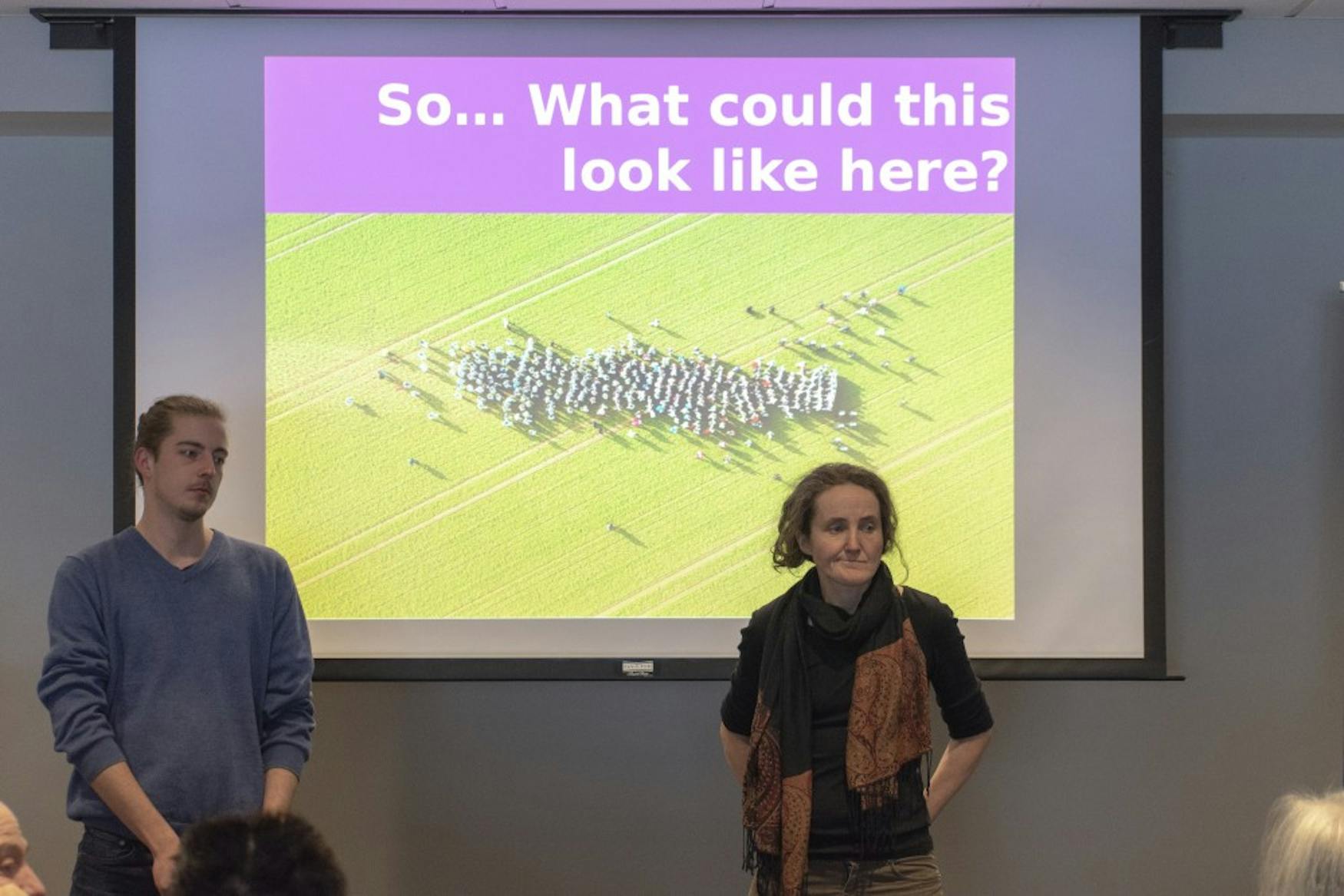German activists discuss the fight for climate justice
The speakers belong to the German environmental advocacy organization Ende Gelände.
As part of their U.S. tour, two German activists, Dorothee Haeusermann and Daniel Tyll Hofinger, shared stories and discussed their experiences advocating for climate justice last Thursday. The activists belong to the climate justice organization Ende Gelände, which aims to mobilize people to fight for climate justice by stopping coal mines and protecting the Hambach Forest. In English, Ende Gelände means “here and no further.”
Haeusermann and Tyll Hofinger explained the work of Ende Gelände in three broad categories: what Ende Gelände is, how it works within the environmental politics of Germany and what made the anti-coal movement successful. In their opening video, protesters on screen chanted, “We are unstoppable, another world is possible.”
Tyll Hofinger began by explaining German politics and showed the audience a map of Germany and its neighboring countries, the Netherlands and France. He pointed out three open-cast mines, or open pits that resources are removed from, adding that 11 million people live near those mines, and could experience adverse effects from this proximity.
“The power plants that are fueled by [these mines]… are actually Europe’s largest source of [carbon dioxide],” and emit a hundred million tons of the gas, according to Tyll Hofinger. In order to slow the effects of climate change, he said, Ende Gelände strives to drastically reduce these practices. He added that although Germany is often credited as the leader for climate justice, and that 30-40 percent of Germany’s power comes from renewable energy, 60 percent still comes from fossil fuels. Therefore, Tyll Hofinger said, there is more work to do in the future to reduce coal extraction. Ende Gelände’s movement has gathered momentum in Germany and surrounding nations such as Italy, Belgium and the Netherlands, and now has a total of 40 local groups that comprise the overall organization.
In addition, the Hambacher Forest, located south of the Hambacher coal mine, was set to be cut down in 2012, but activists started to occupy the forest in protest. Last September, 31,000 police officers evicted those who resided there, destroying up to 93 houses in the forest, sparking more debates about the extraction of fossil fuels. Just over 50,000 people participated in the largest anti-coal climate justice demonstration that Germany has ever had. Although the Coal Commission said the Hambacher Forest is safe, Tyll Hofinger said that the younger generation knows that work needs to be done to protect it from further threats.
One step further from the demonstration are the acts of civil disobedience that Ende Gelände uses — such as sitting on the railroad tracks used to transport coal to “interrupt [mines’] dirty business,” according to Tyll Hofinger. In fact, this act of civil disobedience worked to stop the Hambacher Mine project for “a day or two,” he added. These blockades of mines have two purposes: acting as a physical blockade with bodies, but also as a symbolic “intervention for discourse.”
Haeusermann said that while Ende Gelände has been “successful,” and climate justice has moved onto the mainstream political stage, their work is not done because there still has not been a complete phase out of fossil fuels.
Ende Gelände and the issues they address have made German national news. The organization participates in a series of “Red Line” events, which deal with what will happen if humans continue to dig coal and pass ecological limits. Ende Gelände also hosts climate camps, where people attend workshops, organize their own electricity supply and plan their own methods of activism.
Haeusermann and Tyll Hofinger also discussed the potentially traumatizing risks people face when they participate in demonstrations. One tactic Ende Gelände uses is dispersing when police come, as this overwhelms them with the number of demonstrators. However, they said, Ende Gelände does not leave anyone to stand alone. Haeusermann told the audience that, “if there is some trouble, real trouble … there is legal support and emotional support for people.” Tyll Hofinger added, “We were sitting on those tracks with two and a half thousand people and police. They did not evict us, because there is no way, no police station is large enough. So they found a legal reason [for] why it is actually not illegal for us to be there.” This resulted in laughs from the audience — law enforcements were acknowledging why demonstrators had every right to be acting how they were.
Ende Gelände prepares for these demonstrations year-round, but most actions are taken in the summer months. Now, individual chapters also perform their own, separate demonstrations. But when the joint acts of civil disobedience take place, buses and cars come in from all over Germany and other countries, including Belgium, the Netherlands and Italy, with eager participants.



Please note All comments are eligible for publication in The Justice.